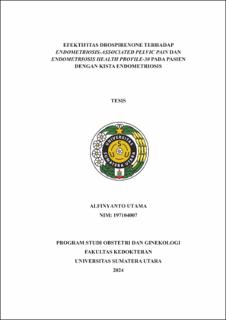| dc.description.abstract | Background: Endometriosis is a chronic gynecological disease commonly
occurring in women of reproductive age, characterized by the presence of endometrial tissue outside the uterus. This condition causes chronic pelvic pain, infertility, and significantly reduces the quality of life of affected individuals. Although its prevalence varies, it is estimated to affect approximately 6-10% of women of reproductive age. Drospirenone, a progestogen with anti-androgenic properties, has demonstrated superior efficacy in alleviating endometriosis symptoms, making it a potential option for hormonal treatment. Further studies are needed to evaluate the effectiveness of Drospirenone in patients with endometriosis cysts and related symptoms, such as chronic pelvic pain and infertility. Method: This study is an experimental research with a pretest and posttest design conducted on patients with endometriosis cysts at Prof. Dr. Chairuddin Panusunan Lubis Hospital, USU Medan, and Stella Maris Maternal and Child Hospital. The inclusion criteria for this study are: women aged 18-45 years diagnosed with cysts, experiencing subjective symptoms such as dysmenorrhea, dyspareunia, and chronic pelvic pain, not currently consuming or using hormonal medications in the past 3 months, no history of malignancy, not undergoing treatment for mood disorders or mental illness, and not undergoing surgical interventions during the study. The exclusion criteria are: women who are unwilling or lost to follow-up and those who become pregnant during the study. Research subjects meeting the inclusion and exclusion criteria were given the Visual Analog Scale (VAS) and Endometriosis Health Profile (EHP-30) questionnaires before and after receiving Drospirenone 4 mg therapy for 12 weeks. Result: Among 21 women with endometriosis, the average age was 31.95 ± 9.04 years, with 57.1% having a normal BMI and 66.7% identified as nulliparous. Daily administration of 4 mg drospirenone for 12 weeks significantly reduced Visual Analog Scale (VAS) scores related to dysmenorrhea, dyspareunia, and endometriosis-associated pelvic pain (P<0.05 for all symptoms). A significant reduction in cyst size was also observed after 12 weeks of treatment. Additionally, the daily administration of 4 mg drospirenone for 12 weeks effectively improved the quality of life in patients with endometriosis, as assessed by the EHP-30 questionnaire (P<0.05 across all analyzed domains). Conclusion: Drospirenone is considered effective in reducing symptoms of dysmenorrhea, dyspareunia, and endometriosis-associated pelvic pain, decreasing cyst size, and improving the quality of life of endometriosis patients after 12 weeks of therapy. | en_US |


